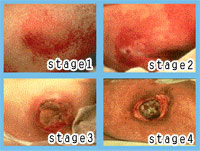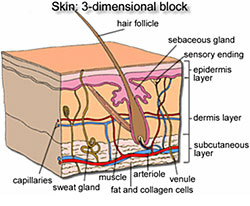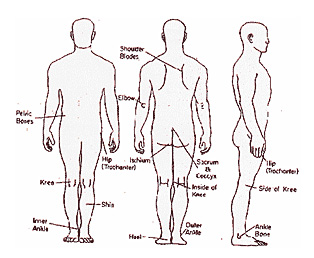




WHAT ARE PRESSURE SORES?
Pressure sores are localized area of dead tissue, which
are primarily cause by unrelieved pressure, For example when a patient lies in
one position for a long time, although there are many other factors which
influence their development, such as incontinence and poor nutrition. The areas
of the body most at risk of pressure sores development are the bony
prominences, such as the ischial tuberosity and sacrum.
example when a patient lies in
one position for a long time, although there are many other factors which
influence their development, such as incontinence and poor nutrition. The areas
of the body most at risk of pressure sores development are the bony
prominences, such as the ischial tuberosity and sacrum.
The body can withstand the high interface pressures for a very short period of time, especially when the hard bony area covered by a thin layer of tissue is in contact with a hard surface(such as a bed, trolley, theatre table, wheelchair), the pressure is not regularly relieved so that damage occurs and pressure sores develop.

STRUCTURE OF THE SKIN
The skin is essentially our largest organ and made from three distinct layers. The top surface called the epidermis which is rough and microscopically thin, this is constantly being worn away and replaced throughout our life span. Underlying the epidermis is viable dermis consists of nerves, glands, fatty tissue and muscle. Beneath the dermis is a subcutaneous layer of adipose tissue containing a large number of blood vessels.
PRESSURE SORE SYMPTOMS
Unrelieved pressure on a specific area of the
body (eg. the heel s, the hips) will affect the blood supply to the skin and
underlying tissues causing that area to become damaged. There are four grades
of pressure sores.
s, the hips) will affect the blood supply to the skin and
underlying tissues causing that area to become damaged. There are four grades
of pressure sores.
Grade 1: the skin is not broken but the color of the
skin changes, purple or red and the irritated skin may feel warmer than
the skin around it.
Grade 2: partial thickness skin loss involving epidermis, dermis
or both superficial damage presenting as blister or abrasion(EPUAP 2001).
Grade
3: damage to the body tissue begins to develop and the sore becomes more
than a surface wound as it affects the tissue underneath the skin.
Grade 4: the
sore has eroded deeply, causing damage to body tissue, bone, muscle, tendons
and joints, the risk of infection is much higher at this stage.